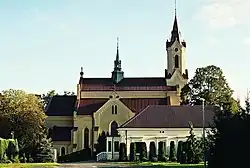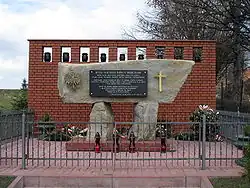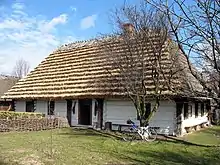Markowa | |
|---|---|
Village | |
 Church of Saint Dorothy in Markowa | |
 Markowa | |
| Coordinates: 50°1′13″N 22°18′1″E / 50.02028°N 22.30028°E | |
| Country | |
| Voivodeship | Subcarpathian |
| County | Łańcut |
| Gmina | Markowa |
| Population | 4,100 |
| Time zone | UTC+1 (CET) |
| • Summer (DST) | UTC+2 (CEST) |
| Vehicle registration | RLA |
| Catholic diocese | Archdiocese of Przemyśl |
| Feast day | 6 February (Feast of Saint Dorothy) 7 July (Feast of Blesseds Ulma Family) |
| Patron saints | |
Markowa [marˈkɔva] is a village in Łańcut County, Subcarpathian Voivodeship, in south-eastern Poland. It is the seat of the gmina (administrative district) called Gmina Markowa. It lies approximately 8 kilometres (5 miles) south-east of Łańcut and 22 kilometres (14 miles) east of the regional capital Rzeszów.[1]
History
The village was founded in the 14th century by the Polish noble family of Pilecki, and was settled by the descendants of Germans colonists, who called it Markhof. The Pileckis also founded a Catholic parish in the village.

During World War II it was under German occupation.
On 24 March 1944 a patrol of German police came to the house of Józef and Wiktoria Ulma, where they found eight Jewish members of the Szall and Goldman families. At first the Germans executed all the Jews. Then they shot the pregnant Wiktoria and her husband. When the six children began to scream at the sight of their parents' bodies, Joseph Kokott, a German police officer (Volksdeutsche from Koblov in Hlučín Region), shot them after consulting with his superior. The other killers were Eilert Dieken, Michael Dziewulski and Erich Wilde. Afterwards the Germans robbed the house and workshop of the Ulma family and organized an alcoholic libation.[2] On the 60th anniversary of this tragedy, a memorial[3] was erected in memory of the family. The family was beatified by the Catholic Church, with the ceremony taking place in Markowa on 10 September 2023 by papal delegate Cardinal Marcello Semeraro.[4] Other Polish families also hid Jews in Markowa, and at least 17 Jews survived the German occupation and the Holocaust in five Polish homes.[2]
The Markowa Ulma-Family Museum of Poles Who Saved Jews in World War II is located in the village.[5]
See also

References
- ↑ "Central Statistical Office (GUS) - TERYT (National Register of Territorial Land Apportionment Journal)" (in Polish). 2008-06-01.
- 1 2 Alfred Kyc. "67. rocznica zamordowania Ulmów i ukrywanych przez nich Żydów". Nauka w Polsce (in Polish). Retrieved 11 September 2020.
- ↑ "Riesenbach Survival Story - Joe Riesenbach". www.riesenbach.com.
- ↑ "https://standard.sk/434995/po-prvy-raz-blahorecili-celu-rodinu-ulmovcov-z-polska-zavrazdenych-nacistami" [An entire family beatified for the first time - Ulmas from were killed by the Nazis]. www.standard.sk (in Slovak). 10 September 2023. Retrieved 11 September 2023.
{{cite web}}: External link in|title= - ↑ "Markowa: Około 50 tys. turystów odwiedziło Muzeum Polaków Ratujących Żydów - Wydarzenia lokalne". www.portalsamorzadowy.pl.
External links
![]() Media related to Markowa at Wikimedia Commons
Media related to Markowa at Wikimedia Commons
- The Righteous and their world. Markowa through the lens of Józef Ulma, by Mateusz Szpytma, Institute of National Remembrance, Poland
- Franciszek Kotula, "Pochodzenie domów przysłupowych w Rzeszowskiem." Kwartalnik Historii Kultury Materialnej Jahr. V., Nr. 3/4, 1957, S. 557
- Story of the survival of the Riesenbach family
- Gisele Hildebrandt, Otto Adamski. Dorfimfersuchungen in dem alten deutsch-ukrainischen Grenzbereich von Landshuf. 1943. Kraków. Markowa